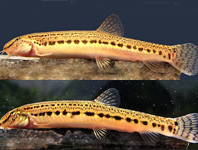Abstract
Analyses of polytene chromosomes revealed a new cryptic species of black fly, Simulium praelargum “IL”, in the Simulium (Nevermania) feuerborni group from Darjeeling, West Bengal, India. This new species occurred sympatrically with two other previously recognized species in the S. praelargum complex: Simulium praelargum Datta sensu stricto and Simulium praelargum “IIIL-1.2”. Chromosome arms IS, IIS, IIL, and IIIS of the new species showed no differences in banding patterns, compared with the sequences in Simulium praelargum s. s. and Simulium praelargum “IIIL-1.2”. Chromosome arm IIIL of the new species was identical to that of S. praelargum s. s., but differed from that of S. praelargum “IIIL-1.2” by two fixed inversions. Chromosome arm IL of the new species differed from that of both species by four fixed inversions: IL-1, IL-2, IL-3, and IL-4. The new species and S. praelargum s. s. lacked a chromocenter, which was present in S. praelargum “IIIL-1.2”. Sex chromosomes of the new species were cytologically undifferentiated (X0X0, X0Y0) and all specimens were monomorphic for autosomal inversion polymorphisms. Speciation in the S. feuerborni group, unlike in many other simuliid taxa, did not involve cytological differentiation of sex chromosomes.
References
Adler, P.H. (2005) Black flies, the Simuliidae. In Marquardt, W.C. (Ed.), Biology of Disease Vectors. 2nd Edition. Elsevier Academic Press, San Diego, CA, pp. 127−140.
Adler, P.H. & Crosskey, R.W. (2015) Cytotaxonomy of the Simuliidae (Diptera): a systematic and bibliographic conspectus. Zootaxa, 3975 (1), 1−139.
https://doi.org/10.11646/zootaxa.3975.1.1Adler, P.H. & Crosskey, R.W. (2016) World blackflies (Diptera: Simuliidae): a comprehensive revision of the taxonomic and geographical inventory. Available from: http://www.clemson.edu/cafls/biomia/pdfs/blackflyinventory.pdf (accessed 20 February 2017)
Adler, P.H., Yadamsuren, O. & Procunier, W.S. (2016) Chromosomal translocations in black flies (Diptera: Simuliidae): facilitators of adaptive radiation? PLoS ONE, 11 (6), e0158272.
https://doi.org/10.1371/journal.pone.0158272Bedo, D.G. (1976) Polytene chromosomes in pupal and adult black flies (Diptera: Simuliidae). Chromosoma, 57, 387−396.
https://doi.org/10.1007/BF00332162Brockhouse, C. (1985) Sibling species and sex chromosomes in Eusimulium vernum (Diptera: Simuliidae). Canaadian Jounal of Zoology, 63, 2145–2161.
https://doi.org/10.1139/z85-316Datta, M. (1975) A new black fly species (Simuliidae-Diptera) from the Darjeeling area, India. Proceedings of the Indian Academy of Science, 81 B (2), 67–74.
Dey, S.K. & Fumafartsok, T.W. (1984) Supernumerary chromosomes in two species of blackflies (Diptera: Simuliidae). Cell & Chromosome Research, 7, 28–30.
Dey, S.K., Henry, W. & Varma, R. (1993) The salivary gland chromosomes of the black fly Simulium (Simulium) singtamense (Diptera: Simuliidae). Cytologia, 58, 299−304.
https://doi.org/10.1508/cytologia.58.299Hadi, U.K., Takaoka, H. & Aoki, C. (1996) Larval polytene chromosomes of three Japanese blackfly species (Diptera: Simuliidae). Medical Entomology & Zoology, 47, 47–54.
https://doi.org/10.7601/mez.47.47_1Henry, W., Dey, S.K. & Varma, R. (2009) The salivary gland chromosomes of the black fly Simulium (Simulium) dentatum (Diptera: Simuliidae). Zoological Science, 26, 216−219.
https://doi.org/10.2108/zsj.26.216Henry, W., Dey, S.K., Varma, R., Thapa, S. & Procunier, W.S. (2010) Polytene chromosomes of an Indian Himalayan black fly Simulium (Nevermannia) praelargum (Diptera: Simuliidae). Current Zoology, 56 (4), 437–444.
Hunter, F.F. & Connolly, V. (1986) A cytotaxonomic investigation of seven species in the Eusimulium vernum group (Diptera: Simuliidae). Canadian Journal of Zoology, 64, 296–311.
https://doi.org/10.1139/z86-050Kuvangkadilok, C., Phayuhasena, S. & Baimai, V. (1999) Population cytogenetic studies on Simulium feuerborni Edwards (Diptera: Simuliidae) from Northern Thailand. Genome, 42, 80–86.
http://dx.doi.org/10.1139/gen-42-1-80Kuvangkadilok, C., Lualon, U. & Baimai, V. (2008) Cytotaxonomy of Simulium siamense Takaoka and Suzuki (Diptera: Simuliidae) in Thailand. Genome, 51, 972−987.
https://doi.org/10.1139/G08-082Low, V.L., Takaoka, H., Pramual, P., Adler, P.H., Ya’cob, Z., Huang, Y.-T., Pham, X.D., Ramli, R., Chen, C.D., Wannaket, A. & Sofian-Azirun, M. (2016) Delineating taxonomic boundaries in the largest species complex of black flies (Simuliidae) in the Oriental Region. Scientific Reports, 6 (20346), 1−8.
https://doi.org/10.1038/srep20346Otsuka, Y., Aoki, C., Saito, K., Hadi, U.K., Suzuki, H. & Takaoka, H. (2001) Phylogenetic analyses of a black fly subgenus Simulium (Nevermannia) based on mitochondrial 16S ribosomal RNA gene sequences. Japanese Journal of Tropical Medicine & Hygiene, 29, 261−266.
https://doi.org/10.2149/tmh1973.29.261Pramual, P. & Wongpakam, K. (2013) Population genetics of the high elevation black fly Simulium (Nevermannia) feuerborni Edwards in Thailand. Journal of Entomological Science, 16, 298–308.
https://doi.org/10.1111/ens.12008Pramual, P., Thaijarern, J., Azirun, M., Ya’cob, Z., Hadi, U. & Takaoka, H. (2015) Cytogenetic and molecular evidence of additional cryptic diversity in high elevation black fly Simulium feuerborni (Diptera: Simuliidae) populations in Southeast Asia. Journal of Medical Entomology, 52, 829–836.
https://doi.org/10.1093/jme/tjv080Procunier, W.S. (1989) Cytological approaches to simuliid biosystematics in relation to the epidemiology and control of human onchocerciasis. Genome, 32, 559−569.
https://doi.org/10.1139/g89-483Rothfels, K.H. (1979) Cytotaxonomy of black flies (Simuliidae). Annual Review of Entomology, 24, 507–539.
https://doi.org/10.1146/annurev.en.24.010179.002451Rothfels, K., Feraday, R. & Kaneps, A. (1978) A cytological description of sibling species of Simulium venustum and S. verecundum with standard maps for the subgenus Simulium Davies [sic] (Diptera). Canadian Journal of Zoology, 56, 1110–1128.
https://doi.org/10.1139/z78-155Takaoka, H., Thapa, S. & Henry, W. (2010) Description of two new species of Simulium (Gomphostilbia) (Diptera: Simuliidae) from Darjeeling, India. Medical Entomology & Zoology, 61, 105−110.
https://doi.org/10.7601/mez.61.105Takaoka, H., Thapa, S. & Henry, W. (2011) A new species of black fly (Diptera: Simuliidae) with an entirely yellow thorax from Darjeeling, India. Zootaxa, 2824, 62–68.
Tangkawanit, U., Kuvangkadilok, C., Baimai, V. & Adler, P.H. (2009) Cytosystematics of the Simulium tuberosum group (Diptera: Simuliidae) in Thailand. Zoological Journal of the Linnean Society, 155, 289−315.
https://doi.org/10.1111/j.1096-3642.2008.00433.xThanwasi, A., Kuvangkadilok, C. & Baimai, V. (2006) Molecular phylogeny of black flies (Diptera: Simuliidae) from Thailand, using ITS rDNA. Genetica, 128, 177−204.
https://doi.org/10.1007/s10709-005-5702-zThapa, S., Procunier, W., Henry, W. & Chhetri, S. (2014) Heterochromatin and sibling species of Simulium praelargum s.l. (Diptera: Simuliidae). Genome, 57, 223–232.
https://doi.org/10.1139/gen-2014-0025

